Qantas Airlines: Organizational Development and Globalization
VerifiedAdded on 2023/06/12
|7
|1395
|388
Report
AI Summary
This report provides an analysis of Qantas Airways' organizational development and change management strategies in the context of globalization. It begins by defining organizational development and its relationship to change management, highlighting the evolution of these concepts from human relations studies. The report then offers background information on Qantas, including its history, market position, and operational hubs. It identifies challenges facing Qantas, such as union negotiations, low-profit margins on international flights, and managing long-distance routes. The report concludes by proposing a future strategy for Qantas, emphasizing the need to empower diverse business segments, expand into Asian markets, and form alliances with international airlines to enhance service offerings and market stability. This analysis aims to provide insights into how Qantas can leverage organizational development and change management to address its challenges and achieve its strategic goals.
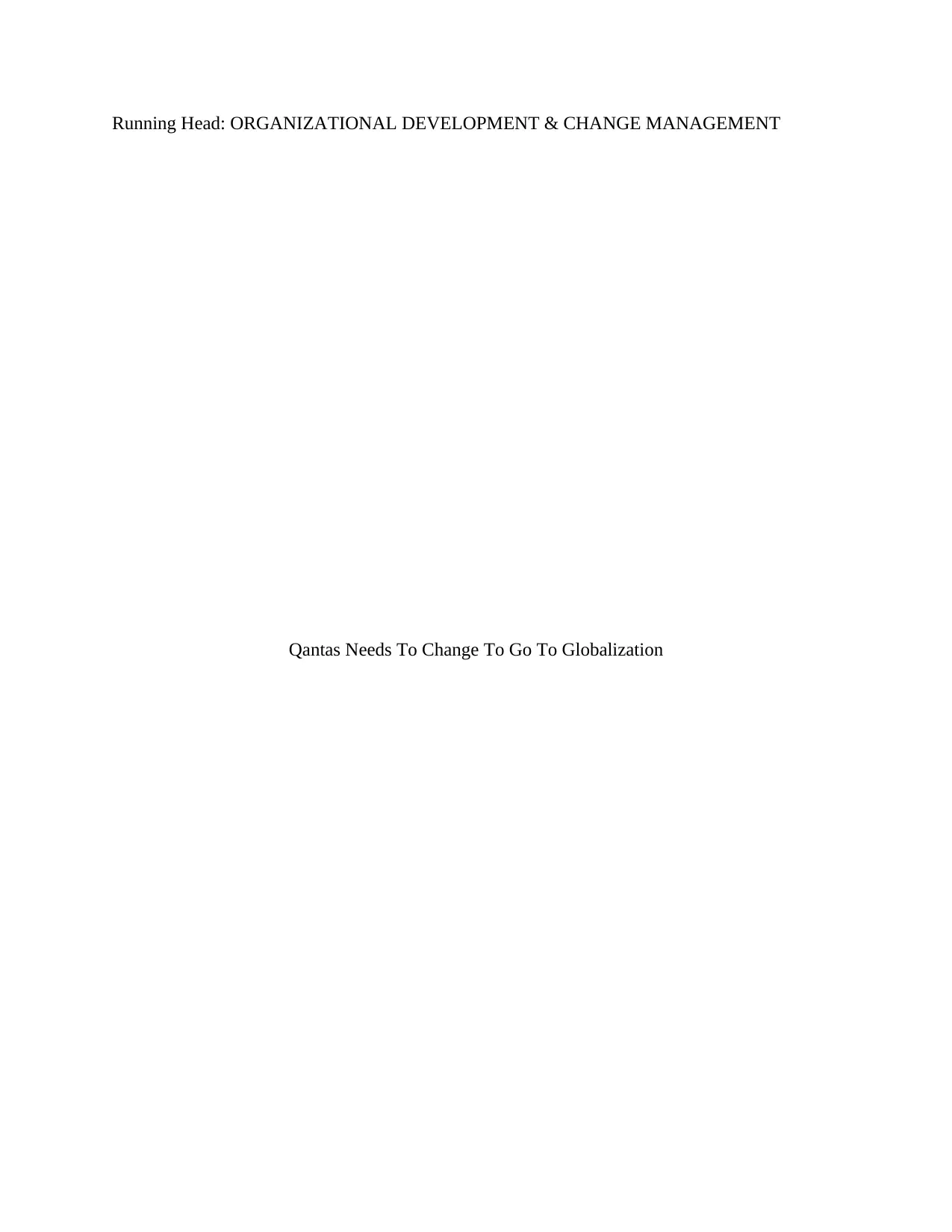
Running Head: ORGANIZATIONAL DEVELOPMENT & CHANGE MANAGEMENT
Qantas Needs To Change To Go To Globalization
Qantas Needs To Change To Go To Globalization
Paraphrase This Document
Need a fresh take? Get an instant paraphrase of this document with our AI Paraphraser
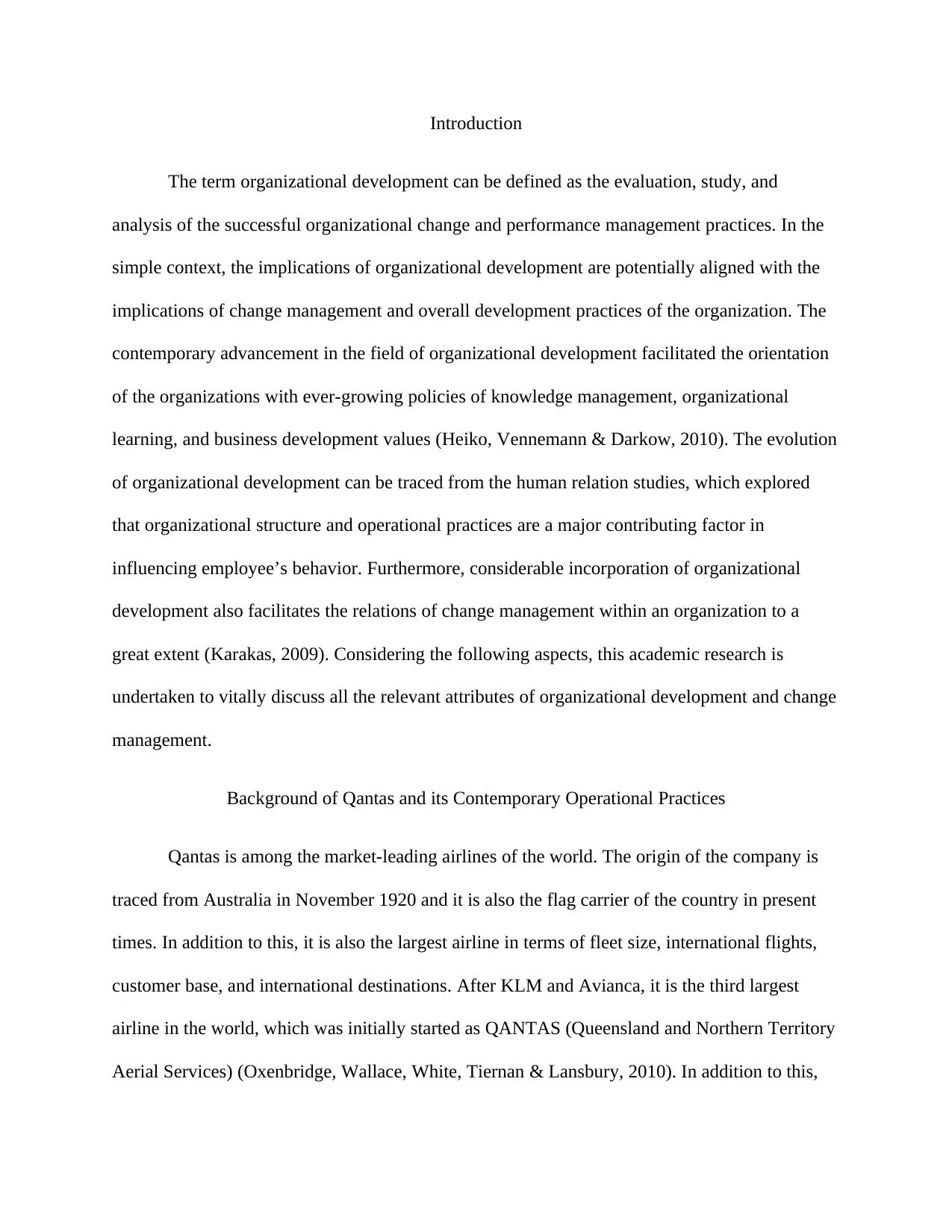
Introduction
The term organizational development can be defined as the evaluation, study, and
analysis of the successful organizational change and performance management practices. In the
simple context, the implications of organizational development are potentially aligned with the
implications of change management and overall development practices of the organization. The
contemporary advancement in the field of organizational development facilitated the orientation
of the organizations with ever-growing policies of knowledge management, organizational
learning, and business development values (Heiko, Vennemann & Darkow, 2010). The evolution
of organizational development can be traced from the human relation studies, which explored
that organizational structure and operational practices are a major contributing factor in
influencing employee’s behavior. Furthermore, considerable incorporation of organizational
development also facilitates the relations of change management within an organization to a
great extent (Karakas, 2009). Considering the following aspects, this academic research is
undertaken to vitally discuss all the relevant attributes of organizational development and change
management.
Background of Qantas and its Contemporary Operational Practices
Qantas is among the market-leading airlines of the world. The origin of the company is
traced from Australia in November 1920 and it is also the flag carrier of the country in present
times. In addition to this, it is also the largest airline in terms of fleet size, international flights,
customer base, and international destinations. After KLM and Avianca, it is the third largest
airline in the world, which was initially started as QANTAS (Queensland and Northern Territory
Aerial Services) (Oxenbridge, Wallace, White, Tiernan & Lansbury, 2010). In addition to this,
The term organizational development can be defined as the evaluation, study, and
analysis of the successful organizational change and performance management practices. In the
simple context, the implications of organizational development are potentially aligned with the
implications of change management and overall development practices of the organization. The
contemporary advancement in the field of organizational development facilitated the orientation
of the organizations with ever-growing policies of knowledge management, organizational
learning, and business development values (Heiko, Vennemann & Darkow, 2010). The evolution
of organizational development can be traced from the human relation studies, which explored
that organizational structure and operational practices are a major contributing factor in
influencing employee’s behavior. Furthermore, considerable incorporation of organizational
development also facilitates the relations of change management within an organization to a
great extent (Karakas, 2009). Considering the following aspects, this academic research is
undertaken to vitally discuss all the relevant attributes of organizational development and change
management.
Background of Qantas and its Contemporary Operational Practices
Qantas is among the market-leading airlines of the world. The origin of the company is
traced from Australia in November 1920 and it is also the flag carrier of the country in present
times. In addition to this, it is also the largest airline in terms of fleet size, international flights,
customer base, and international destinations. After KLM and Avianca, it is the third largest
airline in the world, which was initially started as QANTAS (Queensland and Northern Territory
Aerial Services) (Oxenbridge, Wallace, White, Tiernan & Lansbury, 2010). In addition to this,
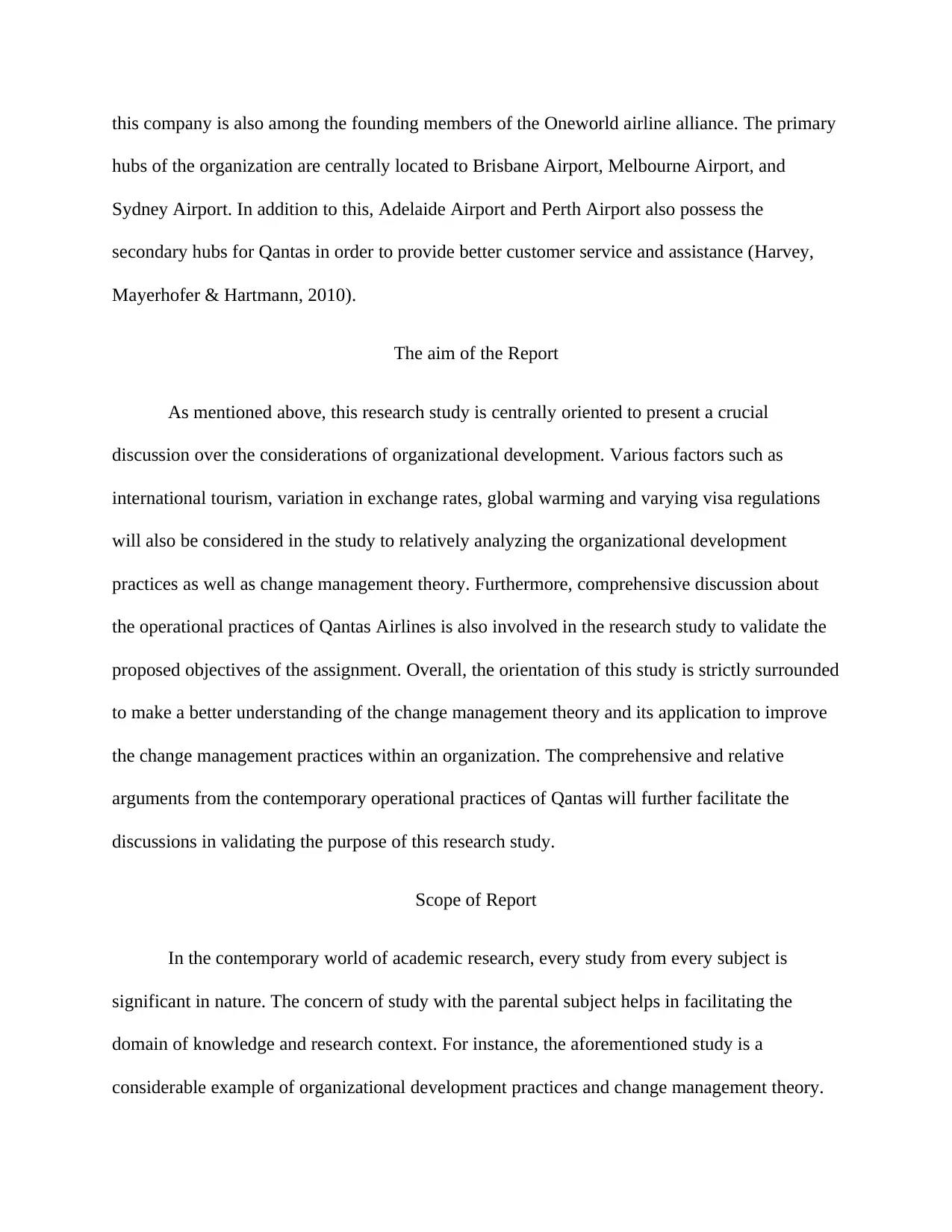
this company is also among the founding members of the Oneworld airline alliance. The primary
hubs of the organization are centrally located to Brisbane Airport, Melbourne Airport, and
Sydney Airport. In addition to this, Adelaide Airport and Perth Airport also possess the
secondary hubs for Qantas in order to provide better customer service and assistance (Harvey,
Mayerhofer & Hartmann, 2010).
The aim of the Report
As mentioned above, this research study is centrally oriented to present a crucial
discussion over the considerations of organizational development. Various factors such as
international tourism, variation in exchange rates, global warming and varying visa regulations
will also be considered in the study to relatively analyzing the organizational development
practices as well as change management theory. Furthermore, comprehensive discussion about
the operational practices of Qantas Airlines is also involved in the research study to validate the
proposed objectives of the assignment. Overall, the orientation of this study is strictly surrounded
to make a better understanding of the change management theory and its application to improve
the change management practices within an organization. The comprehensive and relative
arguments from the contemporary operational practices of Qantas will further facilitate the
discussions in validating the purpose of this research study.
Scope of Report
In the contemporary world of academic research, every study from every subject is
significant in nature. The concern of study with the parental subject helps in facilitating the
domain of knowledge and research context. For instance, the aforementioned study is a
considerable example of organizational development practices and change management theory.
hubs of the organization are centrally located to Brisbane Airport, Melbourne Airport, and
Sydney Airport. In addition to this, Adelaide Airport and Perth Airport also possess the
secondary hubs for Qantas in order to provide better customer service and assistance (Harvey,
Mayerhofer & Hartmann, 2010).
The aim of the Report
As mentioned above, this research study is centrally oriented to present a crucial
discussion over the considerations of organizational development. Various factors such as
international tourism, variation in exchange rates, global warming and varying visa regulations
will also be considered in the study to relatively analyzing the organizational development
practices as well as change management theory. Furthermore, comprehensive discussion about
the operational practices of Qantas Airlines is also involved in the research study to validate the
proposed objectives of the assignment. Overall, the orientation of this study is strictly surrounded
to make a better understanding of the change management theory and its application to improve
the change management practices within an organization. The comprehensive and relative
arguments from the contemporary operational practices of Qantas will further facilitate the
discussions in validating the purpose of this research study.
Scope of Report
In the contemporary world of academic research, every study from every subject is
significant in nature. The concern of study with the parental subject helps in facilitating the
domain of knowledge and research context. For instance, the aforementioned study is a
considerable example of organizational development practices and change management theory.
⊘ This is a preview!⊘
Do you want full access?
Subscribe today to unlock all pages.

Trusted by 1+ million students worldwide
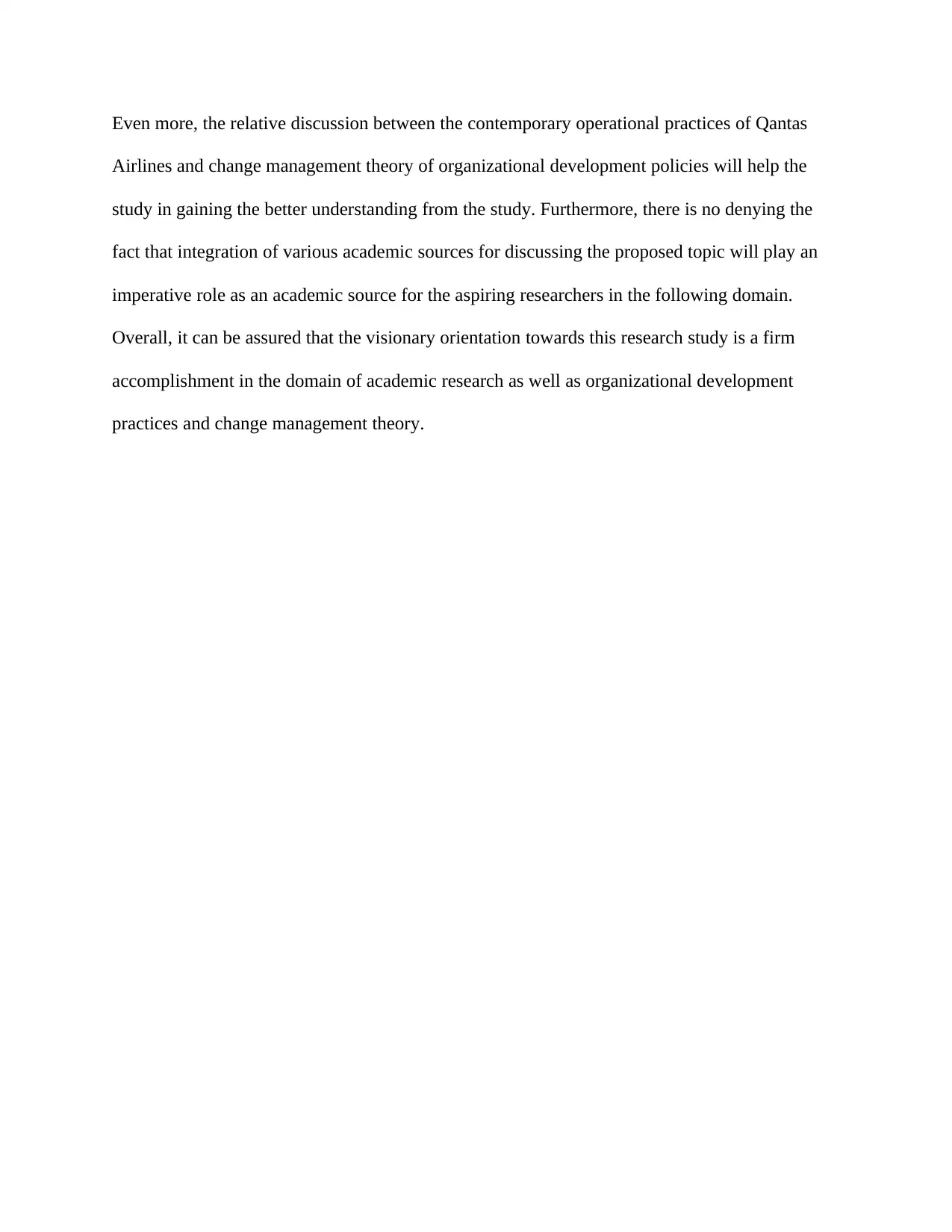
Even more, the relative discussion between the contemporary operational practices of Qantas
Airlines and change management theory of organizational development policies will help the
study in gaining the better understanding from the study. Furthermore, there is no denying the
fact that integration of various academic sources for discussing the proposed topic will play an
imperative role as an academic source for the aspiring researchers in the following domain.
Overall, it can be assured that the visionary orientation towards this research study is a firm
accomplishment in the domain of academic research as well as organizational development
practices and change management theory.
Airlines and change management theory of organizational development policies will help the
study in gaining the better understanding from the study. Furthermore, there is no denying the
fact that integration of various academic sources for discussing the proposed topic will play an
imperative role as an academic source for the aspiring researchers in the following domain.
Overall, it can be assured that the visionary orientation towards this research study is a firm
accomplishment in the domain of academic research as well as organizational development
practices and change management theory.
Paraphrase This Document
Need a fresh take? Get an instant paraphrase of this document with our AI Paraphraser
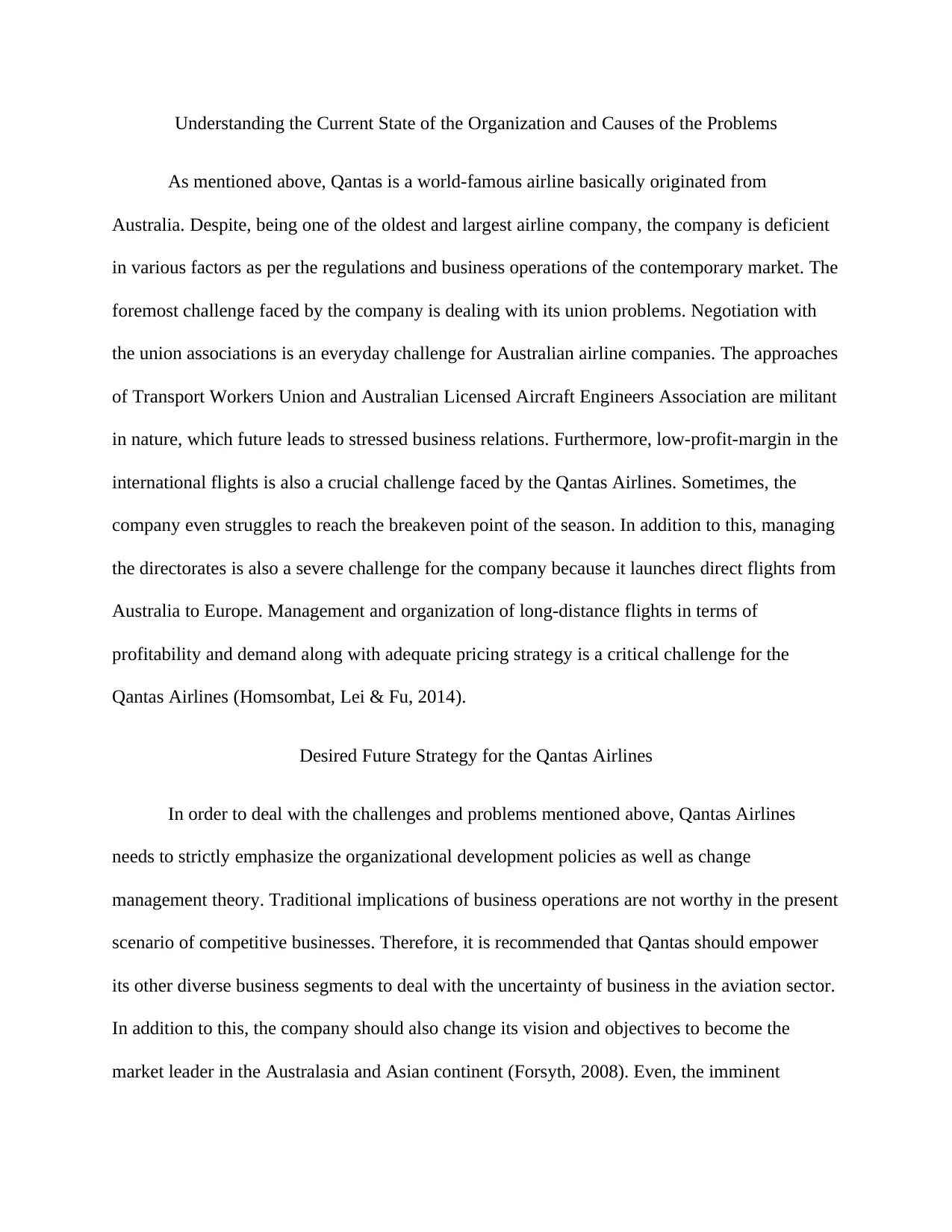
Understanding the Current State of the Organization and Causes of the Problems
As mentioned above, Qantas is a world-famous airline basically originated from
Australia. Despite, being one of the oldest and largest airline company, the company is deficient
in various factors as per the regulations and business operations of the contemporary market. The
foremost challenge faced by the company is dealing with its union problems. Negotiation with
the union associations is an everyday challenge for Australian airline companies. The approaches
of Transport Workers Union and Australian Licensed Aircraft Engineers Association are militant
in nature, which future leads to stressed business relations. Furthermore, low-profit-margin in the
international flights is also a crucial challenge faced by the Qantas Airlines. Sometimes, the
company even struggles to reach the breakeven point of the season. In addition to this, managing
the directorates is also a severe challenge for the company because it launches direct flights from
Australia to Europe. Management and organization of long-distance flights in terms of
profitability and demand along with adequate pricing strategy is a critical challenge for the
Qantas Airlines (Homsombat, Lei & Fu, 2014).
Desired Future Strategy for the Qantas Airlines
In order to deal with the challenges and problems mentioned above, Qantas Airlines
needs to strictly emphasize the organizational development policies as well as change
management theory. Traditional implications of business operations are not worthy in the present
scenario of competitive businesses. Therefore, it is recommended that Qantas should empower
its other diverse business segments to deal with the uncertainty of business in the aviation sector.
In addition to this, the company should also change its vision and objectives to become the
market leader in the Australasia and Asian continent (Forsyth, 2008). Even, the imminent
As mentioned above, Qantas is a world-famous airline basically originated from
Australia. Despite, being one of the oldest and largest airline company, the company is deficient
in various factors as per the regulations and business operations of the contemporary market. The
foremost challenge faced by the company is dealing with its union problems. Negotiation with
the union associations is an everyday challenge for Australian airline companies. The approaches
of Transport Workers Union and Australian Licensed Aircraft Engineers Association are militant
in nature, which future leads to stressed business relations. Furthermore, low-profit-margin in the
international flights is also a crucial challenge faced by the Qantas Airlines. Sometimes, the
company even struggles to reach the breakeven point of the season. In addition to this, managing
the directorates is also a severe challenge for the company because it launches direct flights from
Australia to Europe. Management and organization of long-distance flights in terms of
profitability and demand along with adequate pricing strategy is a critical challenge for the
Qantas Airlines (Homsombat, Lei & Fu, 2014).
Desired Future Strategy for the Qantas Airlines
In order to deal with the challenges and problems mentioned above, Qantas Airlines
needs to strictly emphasize the organizational development policies as well as change
management theory. Traditional implications of business operations are not worthy in the present
scenario of competitive businesses. Therefore, it is recommended that Qantas should empower
its other diverse business segments to deal with the uncertainty of business in the aviation sector.
In addition to this, the company should also change its vision and objectives to become the
market leader in the Australasia and Asian continent (Forsyth, 2008). Even, the imminent
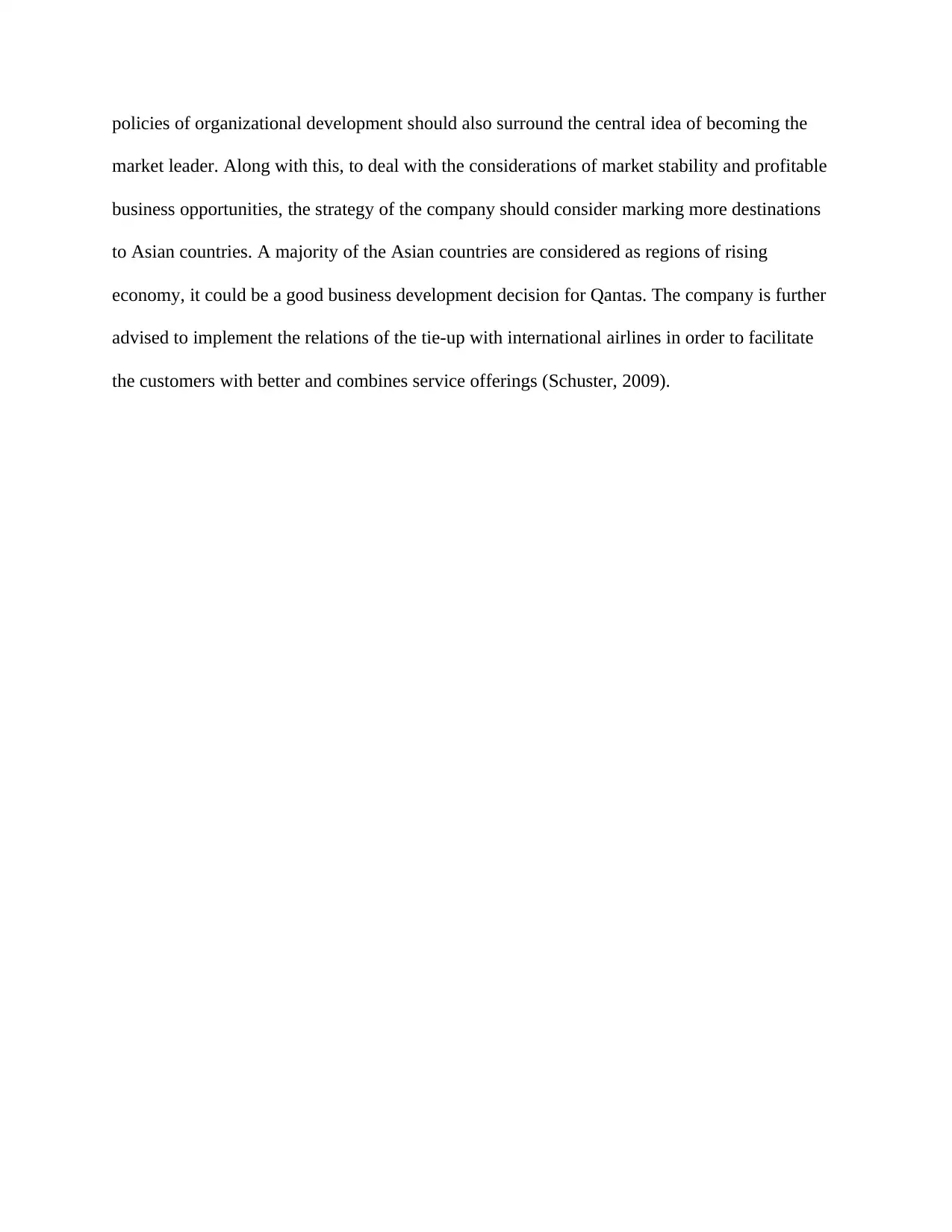
policies of organizational development should also surround the central idea of becoming the
market leader. Along with this, to deal with the considerations of market stability and profitable
business opportunities, the strategy of the company should consider marking more destinations
to Asian countries. A majority of the Asian countries are considered as regions of rising
economy, it could be a good business development decision for Qantas. The company is further
advised to implement the relations of the tie-up with international airlines in order to facilitate
the customers with better and combines service offerings (Schuster, 2009).
market leader. Along with this, to deal with the considerations of market stability and profitable
business opportunities, the strategy of the company should consider marking more destinations
to Asian countries. A majority of the Asian countries are considered as regions of rising
economy, it could be a good business development decision for Qantas. The company is further
advised to implement the relations of the tie-up with international airlines in order to facilitate
the customers with better and combines service offerings (Schuster, 2009).
⊘ This is a preview!⊘
Do you want full access?
Subscribe today to unlock all pages.

Trusted by 1+ million students worldwide
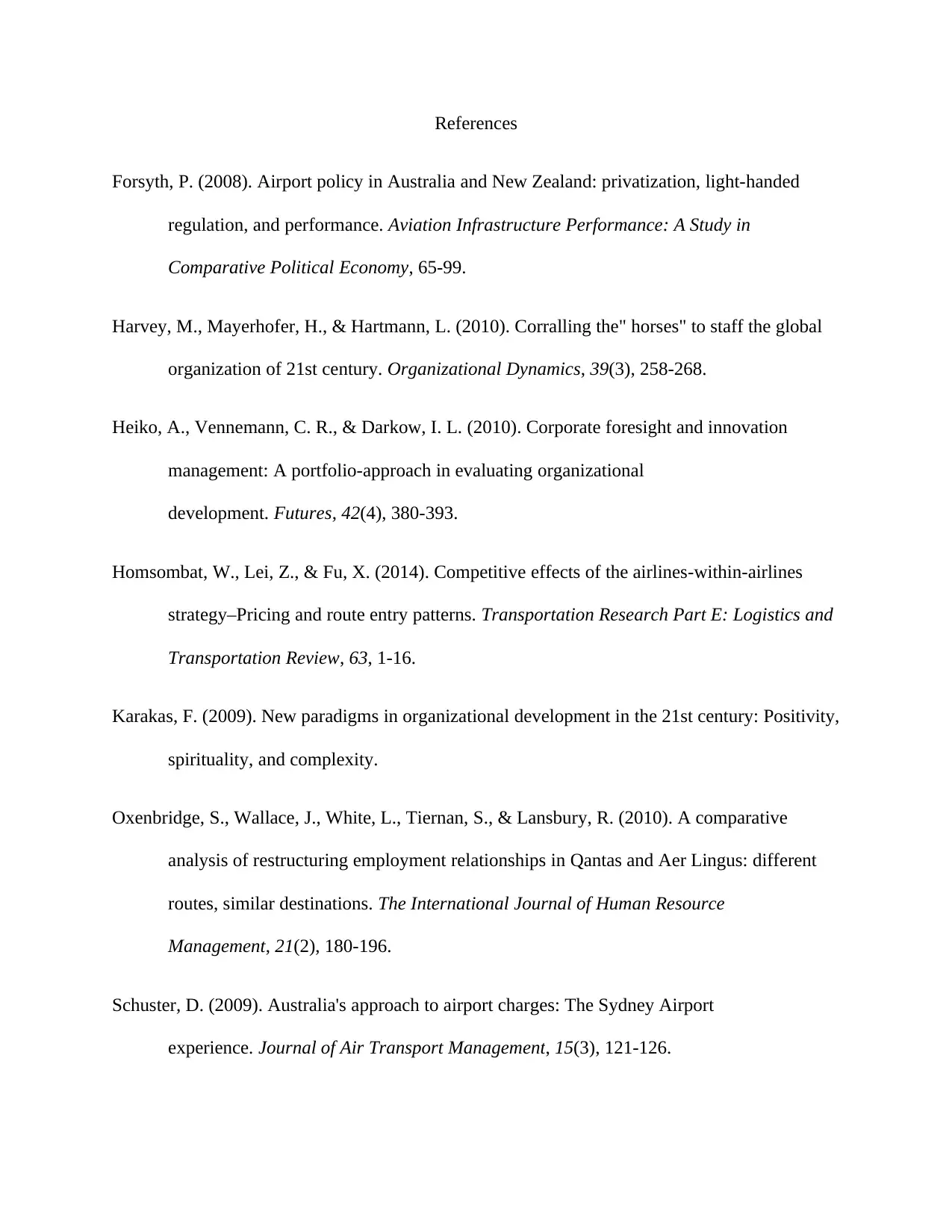
References
Forsyth, P. (2008). Airport policy in Australia and New Zealand: privatization, light-handed
regulation, and performance. Aviation Infrastructure Performance: A Study in
Comparative Political Economy, 65-99.
Harvey, M., Mayerhofer, H., & Hartmann, L. (2010). Corralling the" horses" to staff the global
organization of 21st century. Organizational Dynamics, 39(3), 258-268.
Heiko, A., Vennemann, C. R., & Darkow, I. L. (2010). Corporate foresight and innovation
management: A portfolio-approach in evaluating organizational
development. Futures, 42(4), 380-393.
Homsombat, W., Lei, Z., & Fu, X. (2014). Competitive effects of the airlines-within-airlines
strategy–Pricing and route entry patterns. Transportation Research Part E: Logistics and
Transportation Review, 63, 1-16.
Karakas, F. (2009). New paradigms in organizational development in the 21st century: Positivity,
spirituality, and complexity.
Oxenbridge, S., Wallace, J., White, L., Tiernan, S., & Lansbury, R. (2010). A comparative
analysis of restructuring employment relationships in Qantas and Aer Lingus: different
routes, similar destinations. The International Journal of Human Resource
Management, 21(2), 180-196.
Schuster, D. (2009). Australia's approach to airport charges: The Sydney Airport
experience. Journal of Air Transport Management, 15(3), 121-126.
Forsyth, P. (2008). Airport policy in Australia and New Zealand: privatization, light-handed
regulation, and performance. Aviation Infrastructure Performance: A Study in
Comparative Political Economy, 65-99.
Harvey, M., Mayerhofer, H., & Hartmann, L. (2010). Corralling the" horses" to staff the global
organization of 21st century. Organizational Dynamics, 39(3), 258-268.
Heiko, A., Vennemann, C. R., & Darkow, I. L. (2010). Corporate foresight and innovation
management: A portfolio-approach in evaluating organizational
development. Futures, 42(4), 380-393.
Homsombat, W., Lei, Z., & Fu, X. (2014). Competitive effects of the airlines-within-airlines
strategy–Pricing and route entry patterns. Transportation Research Part E: Logistics and
Transportation Review, 63, 1-16.
Karakas, F. (2009). New paradigms in organizational development in the 21st century: Positivity,
spirituality, and complexity.
Oxenbridge, S., Wallace, J., White, L., Tiernan, S., & Lansbury, R. (2010). A comparative
analysis of restructuring employment relationships in Qantas and Aer Lingus: different
routes, similar destinations. The International Journal of Human Resource
Management, 21(2), 180-196.
Schuster, D. (2009). Australia's approach to airport charges: The Sydney Airport
experience. Journal of Air Transport Management, 15(3), 121-126.
1 out of 7
Related Documents
Your All-in-One AI-Powered Toolkit for Academic Success.
+13062052269
info@desklib.com
Available 24*7 on WhatsApp / Email
![[object Object]](/_next/static/media/star-bottom.7253800d.svg)
Unlock your academic potential
Copyright © 2020–2025 A2Z Services. All Rights Reserved. Developed and managed by ZUCOL.





